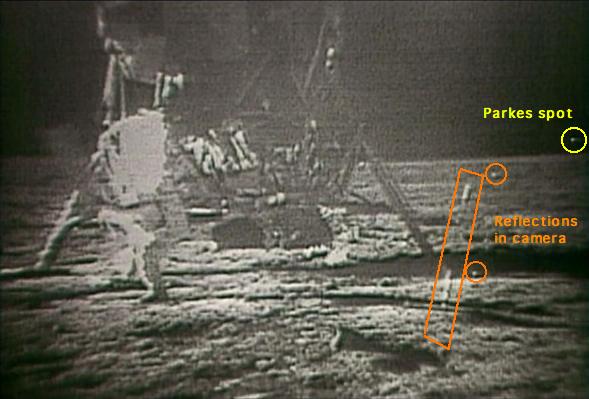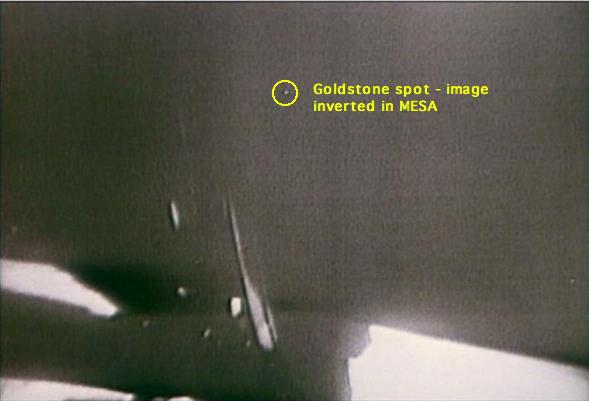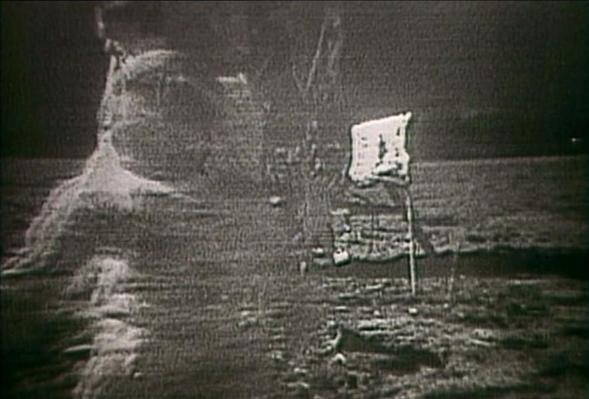

Note: The following discussion refers to full-size Apollo video. Video sources viewed on conventional TV sets are usually seen with cropped borders and the 'Parkes spot' discussed below will not be visible. The same sources viewed on computer monitors will usually be seen at full size and the 'Parkes spot' will be visible.
During the Apollo 11 EVA, NASA had a choice of using received television signals from three stations: Goldstone (GDS) in California; Parkes (PKS) in central New South Wales, Australia; and Honeysuckle Creek (HSK) near Canberra, Australia. During the first few minutes of the EVA, NASA used each of the three signals at various times and, in this note, we discuss artifacts unique to each of the signals which allow determination as to which of the three signals was in use at any particular time. Much of this information is presented in John Sarkissian's On Eagle's Wings: The Parkes Observatory's Support of the Apollo 11 Mission.
As Sarkissian notes, a number of peculiar image artifacts were seen in the video signal provided to the global television audience. One set of these artifacts originated in the TV camera and were either transient, after-images of bright objects in the field-of-view or were secondary images of bright objects produced by extra reflections in the camera optics. An example of the latter is a prominent bright streak which, in Figure 1, appears to the right of the US flag. It is a secondary image of the bright, sunlit, north (plus-Y) strut of the LM. Whenever either of the astronauts walked through the portion of the picture containing the bright streak, it appears to be visible through them. Additionally, when either of the astronauts obscures part of the north strut of the LM, the corresponding portion of the bright streak fades. These camera-related artefacts produced the ghostly effects remembered by the public.

What was the origin of the spots? Bill Wood, a USB (Unified S-Band) Lead Engineer at Goldstone during Apollo, suggests that the spots were defects in the targets of the Vidicon camera tubes. Wood writes, "Back in the late 1950s I was responsible for the maintenance of various closed-circuit vidicon TV cameras used to monitor rocket engine tests at the USAF Rocket Engine Test Laboratory and, later, at the Jet Propulsion Laboratory. I would often see white spots on vidicon camera video outputs, especially if the camera was located close enough to the rocket engine being tested to be subject to vibration. Small particles could be dislodged from either the electron gun filament or the target with only moderate vibration. I even found white spots on some new vidicons that came in shock-mounted shipping cartons from the manufacturer. I believe the RCA Slow Scan converters used during Apollo were shipped by air to the several MSFN stations with the vidicon tubes already installed, which would make them more susceptible to vibration in transit. It does not surprise me to see small spots in the Apollo Slow-Scan converter outputs, caused by vibration encountered during shipping and/or installation of the scan converters."
When the signals at Goldstone and Parkes were scan-converted, the spots were always present in the scan-converted signals. The Goldstone images had a white spot located about one quarter of the image height up from the bottom, except when an inversion switch in the electronics was 'on' to compensate for the TV being upside down on the MESA. When the inversion switch was 'on', the Goldstone spot was about one quarter of the image height down from the top. (During one Goldstone sequence, the image is shown in 'negative' mode and the spot is black). The Parkes pictures had a white spot located about one third of the image height down from the top near the righthand edge, except when the inversion switch was 'on', which put the spot one third of the image height up from the bottom near the lefthand edge. Finally, no such spots have been identified in the scan-converted Honeysuckle Creek signals. The fact that images from each of the stations has a distinctive 'mark' has proved to be fortuitous, because it allowed Sarkissian to easily identify which of the three signals NASA used at any time during the moonwalk.
Figure 2 shows the Goldstone spot with the camera upside down on the MESA and the inversion switch 'on'.


|
||||||||||||||||||||||||||||||||||||||||||||||||||||||||||||||||
Colin Mackellar has provided a complete transcript of this portion of the Honeysuckle Creek recording along with the corresponding audio clip. The playback speed has been increased by 11 percent as discussed above.
| Journal Home Page | Apollo 11 Journal | One Small Step |